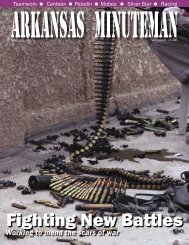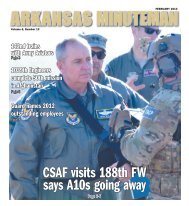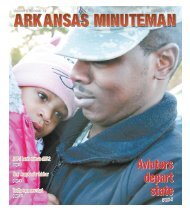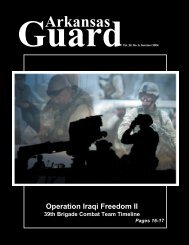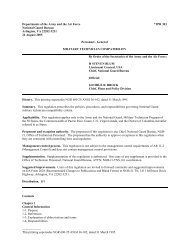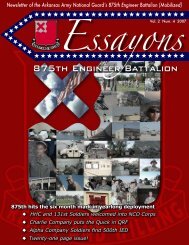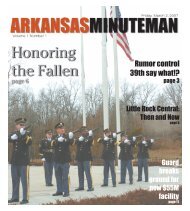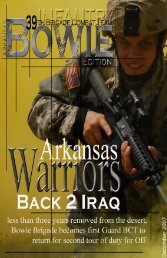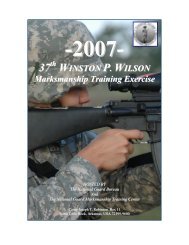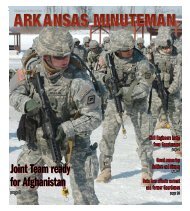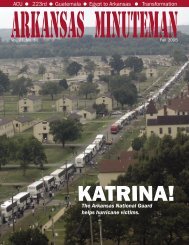THE MUSTANG LEADER - Arkansas National Guard
THE MUSTANG LEADER - Arkansas National Guard
THE MUSTANG LEADER - Arkansas National Guard
- No tags were found...
Create successful ePaper yourself
Turn your PDF publications into a flip-book with our unique Google optimized e-Paper software.
Page 2 The Mustang Leader April 9, 2007Photo by Staff Sgt. Lorin T. SmithStaff Sgt. Brett Graveline, a flight engineer with Co. B, 2nd Bn., 135th Aviation Regt., offloads supplies at Baghdad InternationalAirport in Baghdad, Iraq.air assault missions or movingspace-available passengersacross the country.The Army uses helicoptersto transfer cargo and people tothe smaller bases in Iraq becausethere may not be an airfieldlarge enough for fixed-wingaircraft to land. Company B hasmoved unmanned aerial vehicles,Stryker vehicle parts, Humveetires, mail, and even bubble wrapused in packaging items. “Wemove anything and everything;you name it, we have moved it,”said Chief Warrant Officer MarkGuthrie, from St. Paul, Minn.Chief Warrant Officer Guthrieand his crew recently wenton a mission one cold December,Photo by Staff Sgt. Lorin T. SmithStaff Sgt. George Debono, Co. B, 2nd Bn., 135th Aviation Regt., helps guide in a palletfilled with supplies during a stop at a Coalition base in Baghdad.2006, night. He and his crewdropped off ammunition, blastingcaps, five-gallon fuel cans,and passengers at various Baghdad,Iraq, bases. The only lightin the blacked out CH-47 camefrom the cockpit panel. Switches,buttons, and monitors told thetwo pilots, Chief Warrant OfficerGuthrie and Chief War-
Page 3 The Mustang Leader April 9, 2007Sgt. Brian Cooper, Co. B, 2nd Bn., 135th Aviation Regt., preps the Chinook aircraft so it can be refueled.Photo by Staff Sgt. Lorin T. SmithStaff Sgt. Brett Graveline, a flight engineer with Co. B, 2ndBn., 135th Aviation Regt., watches the Baghdad skyline forenemy activity while manning a machine gun at the back ofa Chinook helicopter on a recent cargo supply mission.rant Officer Doug Pennington,from Aurora, Colo., everythingthey needed to know about theiraircraft. Chief Warrant OfficerGuthrie watched his portablenavigation computer, scanned thehorizon, and continuouslymannedthe radio, talkingto airport towers orwith his crew whileChief Warrant OfficerPennington flewthe Chinook.Behind thepilots sat the doorgunners. BundledPhoto by Staff Sgt. Lorin T. Smith up against the cold,Staff Sgt. Debonoand Sgt. BrianCooper, from Arvada,Colo., vigilantlywatched the ground belowthem. Perched toward the rear ofthe aircraft was Staff Sgt. BrettGraveline, a flight engineer fromAurora. Staff Sgt. Graveline wasresponsible for monitoring thehelicopter’s hydraulics, ensuringthat the fluid pressure and pumptemperature were in the normalrange of operation. He alsomanned the machine gun locatedat the rear of the aircraft. All ofthe crew members remained alertand maintained communicationwith each other about what theysaw in their area of responsibility.Once the crew had deliveredall of the supplies and droppedoff the passengers, they headedhome, excited they had accomplishedtheir mission. ChiefWarrant Officer Guthrie saidhe thinks being a Chinook pilotis the best job in the Army. “Iwould rather be in a cockpit flyingaround the countryside thansitting behind a desk,” he said.
Page 5 The Mustang Leader April 9, 2007Soldiers of the 449th ASB take on the20 kilometer Danish Contingent MarchStory by Staff Sgt. Jim Balderas449th Aviation Support BattalionBAGHDAD, Iraq – Asearly morning light brokeover Baghdad, Iraq, on Dec.1, 2006, hundreds of CoalitionForces Soldiers lined up for theDanish Contingent (DANCON)March. The march includedpersonnel from Denmark, Italy,Australia, the United Kingdomand the United States. Amongthe participants lined up at thestarting line were 18 highlymotivated Soldiers from the449 th Aviation Support Battalion(ASB), 36 th Combat AviationBrigade.The DANCON Marchis a tradition in the DanishArmy that began in 1972. Atthat time, they were deployedto Cyprus and developed themarch as a way to demonstratephysical fitness and enhancecamaraderie through a militarythemed social event. Danishforces deployed around theworld try to hold at least onemarch during each rotation;they have been successful inreaching that goal while servingin Baghdad.Wearing all of their combatequipment, all 18 of the449 th ASB Soldiers finishedthe 20 kilometer DANCONMarch in less than four hours.The course consisted of fivelaps through rugged streets,Photo by Staff Sgt. Lorin T. SmithSgt. Walter Strache, Company A, 449th Aviation Support Battalion, shakes hands with aDanish officer after being awarded the Danish Contingent March medal.bombed out palaces, and securitycheckpoints inside theInternational Zone. “It is atest of your endurance andwill-power,” said Sgt. 1 st ClassJeffrey Printy, HeadquartersServices Company, 449 th ASB.The march was described bySgt. 1 st Class Printy as livingthe Warrior Ethos: “We shallnever quit; we shall never acceptdefeat; and we shall neverleave a fallen comrade.” Thelatter was best demonstrated byCompany A, 449 th ASB’s ownSgt. Walter Strache, who aftercompleting the course, returnedto encourage a fellow Soldierthat had fallen behind. With 60to 80 pounds of gear on theirbacks, it was not surprising thatsome Soldiers began to questiontheir ability to completethe course, and the encouragementSgt. Strache providedhelped the last 449 th Soldiersfinish the course successfully.At the final checkpoint,a Danish Navy Royal Officerwaited for each Soldierto arrive, pinned a DANCONMarch medal on them, andpresented them with a certificateof appreciation. With facesshowing fatigue, and in somecases, throbbing and blisteredfeet, these 18 Soldiers proudlywearing the T-patch of the 36 thInfantry Division, finishedthe march with a sense of accomplishmentthey will neverforget.
Page 6 The Mustang Leader April 9, 2007OSACOM earns 36th ID combat patchStory by Staff Sgt. Jonathan HippOSACOM Public Affairs OfficeLSA ANACONDA, Iraq– The Operational Support AirliftCommand (OSACOM) has beenflying operational missions in acombat zone for the 36 th CombatAviation Brigade (CAB) for 30days or more, which earned theunit the Shoulder Sleeve Insignia-Wartime Service patch, or combatpatch.The history of the shoulderpatch dates back to World War I.Before patches existed in 1918,regional symbolic markers werefound on American vehicles andbaggage in France. These patcheshad distinctive insignias on them,identifying a Soldier’s unit of assignment.During World War II, it wascommon to see European campaignveterans displaying their unit patchon both sleeves of their uniform. In1945, the Army officially declaredthe patch would recognize wartimeservice when worn on the rightshoulder, marking the beginning ofthe combat patch.OSACOM received thecombat patch of the 36 th CAB, alsoknown as the T-patch, in a ceremonyon Jan. 15, 2007, at OSACOMHeadquarters. The T-patch consistsof an olive-drab T on a blue flint arrowheadand was adopted in 1918.The blue flint arrowhead representsOklahoma and the T represents thestate of Texas. Lt. Col. Pat Weber,OSACOM’s commander, said,“Today’s ceremony marks a rite ofpassage. Many Soldiers in our formationalready wear the ShoulderSleeve Insignia denoting formerwartime service from previousPhoto by Master Sgt. Charles A. Wheeler1st Sgt. Javier Acosta, Headquarters and Headquarters Company, Operational SupportAirlift Command, places a combat T-patch on the right shoulder of Maj. Pete Derouin,the Executive Officer for OSACOM, during a combat patch ceremony.deployments, but for many othersthis is their first authorization. Youknow that we often evaluate otherSoldiers by what they wear on theiruniform. A combat patch showsthat they have been tried on thefield of battle and establishes theircredibility of their technologicaland tactical expertise. You’ve allheard the history and lineage of the36 th Infantry Division. It is filledwith their successes from previousconflicts. Today, we become a partof that history as we add the 36 thInfantry Division combat patch toour right shoulders.”The 36 th Infantry Divisionwas organized in July 1917. Various<strong>National</strong> <strong>Guard</strong> organizationsfrom different states were broughttogether to create the division,to include active duty and Reserveunits. 36 th Infantry DivisionSoldiers faced their first taste ofcombat in May 1918, while inFrance. The heritage continued inWorld War II when the “fightingmen of Texas” clung to threatenedbeachheads which were key terrainfor the Allied Forces in Salerno,Italy. The unit served 19 monthsin combat in five major campaignsand two amphibious assaults.After being deactivated formore than 50 years, the “Fighting36 th ” was reactivated in July 2004,to help transform Texas militaryforces in to a more mobile andlethal force committed to helpingfight the Global War on Terrorism.The unit has 15 Medal of Honorwinners and 10 Presidential UnitCitations. Authorization for wearof the combat patch applies only tomembers assigned overseas in anarea designated as a combat zone inaccordance with Army Regulation670-1.
Page 7 The Mustang Leader April 9, 2007The 2nd Bn., 135th Aviation Regt.’s SecurityPlatoon protects Al Kut MEDEVAC companyPhoto by Staff Sgt. Lorin T. SmithPfc. Ryan Forkey, HHC, 2nd Bn., 135th Aviation Regt., fromWatertown, N.Y., provides security for a MEDEVAC crew 11 milesfrom the Iraq-Iran border Jan. 31, 2007. The Platoon is based out ofCamp Delta in Al Kut, Iraq.Photo by Staff Sgt. Lorin T. SmithSgt. Joel Rodriguez, HHC, 2nd Bn., 135th Aviation Regt., fromCollege Station, Texas, provides dismounted security while theSecurity Platoon does a perimeter check of Camp Delta in Al Kut,Iraq. The security team drives the camp’s perimeter daily to checkfor any breaches in the wire and look for any suspicious activity.Photo by Staff Sgt. Lorin T. SmithSpc. Christopher Harter (right), HHC, 2nd Bn., 135th Aviation Regt.,from Wheeling, W.Va., and other Security Platoon Soldiers, exit aMEDEVAC helicopter during a simulated training mission.Photo by Staff Sgt. Lorin T. SmithThe Security Platoon’s mission is to provide force protection forCamp Delta’s MEDEVAC compound.Photo by Staff Sgt. Lorin T. SmithSoldiers from the Security Platoon, HHC, 2nd Bn., 135th AviationRegt., practice entering a helicopter after getting a simulated personnelrecovery call during a MEDEVAC training mission in Al Kut, Iraq.Photo by Staff Sgt. Lorin T. SmithPfc. Ryan Forkey mans a .50 caliber machine gun in an up-armoredHumvee during a training mission at Camp Delta in Al Kut, Iraq.
Page 9 The Mustang Leader April 9, 2007Senior aviation leaders visit the36th CAB for an Aviation SummitStory by Staff Sgt. Lorin T. Smith36th CAB Public Affairs OfficeLSA ANACONDA, Iraq– More than 20 senior leaders fromthe Department of the Army visitedthe 36 th Combat Aviation Brigade(CAB) on March 6, 2007, as partof an Aviation Summit.The Army Vice Chief of StaffGen. Richard Cody directed keyaviation leaders from the Departmentof the Army to come to Iraqto discuss aviation operations insupport of Operation Iraqi Freedomand to receive an update onopen issues from the 2006 Summit.All the battalions within the36 th CAB briefed the distinguishedguests on operations, maintenance,safety, and standardization – allto help the senior aviation leadersgain a better perspective on aviationoperations.The event kicked off with alunch inside Dining Facility #4.Soldiers from the 36 th CAB mingledwith the senior leaders duringmost of the lunch. This allowedaviators that are actually planningand flying the mission in the war toshare tips with some of the leadersfrom the United States Army andDepartment of Defense.After lunch, the senior leaderstoured the 36 th CAB’s battalions.The generals and their staff spentthe majority of the day in and outof battalion tactical operationscenters (TOCs). The majority ofthe briefers for the delegation werenot battalion commanders or commandsergeants major, but juniorSoldiers. Spc. David Rodriguez,Photo by Staff Sgt. R.A. SteeleSgt. 1st Class Seth Yount (right), Headquarters and Headquarters Company, 2nd Battalion,135th Aviation Regiment, briefs Maj. Gen. James H. Pillsbury, Commanding General ofArmy Aviation and Missile Command, about the battalion’s current missions during anAviation Summit March 6, 2007.Photo by Staff Sgt. R.A. SteeleThe 36th CAB Commander Col. Vernon A. Sevier, Jr., (right), discusses aviation operations withBrig. Gen. William Forrester (middle), commander of the U.S. Army Combat Readiness Center,and the 36th CAB Command Sgt. Maj. Glenn L. Peterson (left), outside Aviation Village 2.
Page 10 The Mustang Leader April 9, 2007Photo by Staff Sgt. R.A. SteeleMaj. Kurt Bruggemeyer, the Executive Officer for 1st Battalion, 108th Aviation Regiment, shows the senior aviation leaders differentterrain landmarks on LSA Anaconda, Iraq.Headquarters and HeadquartersCompany, 1 st Battalion, 149 thAviation Regiment (Attack), hadthe opportunity to brief Maj. Gen.James H. Pillsbury, the CommandingGeneral of Army Aviation andMissile Command on TOC operations.He did such a great job thatthe general gave him a Coin ofExcellence.Maj. Gen. Pillsbury and Brig.Gen. Stephen Mundt, Headquarters,Department of the ArmyOperations Officer, had one majorquestion to ask every Soldier theycame across: “If you were king fora day, what would you fix?” “Wewanted to hear about the big issuesin the units – how maintenanceis going, what’s keeping aircraftdown, how we can improve thelives of the Soldiersflying the missions,”Brig. Gen.Mundt said.The conferenceended with a dinnerhosted by the brigade.Soldiers fromthe different battalionscame togetherfor good food andthe chance to askthe senior aviationleaders questionsabout the future ofaviation and thedeployment in Iraq. Overall, theday’s events gave the generals aclose-up view on life in Iraq andhow operations within the battalionsand brigade are being con-Photo by Staff Sgt. R.A. SteeleCapt. Hilliard Kelly (right) and Capt. Scott Nicholas (backleft), HHC, 1st Battalion, 149th Aviation Regiment (Attack),brief Maj. Gen. Pillsbury on the battalion’s TOC operations.ducted. “I couldn’t be more proudto be part of a team than I am ofyour team,” Maj. Gen. Pillsburysaid. “The 36 th CAB, by any measure,by any metric, is a success.”
Page 13 The Mustang Leader April 9, 2007A Job Well Done!Photo by Staff Sgt. Jonathan HippSgt. 1st Class Lynette Streitfield, Operational Support AirliftCommand, is promoted to Master Sergeant by OSACOM CommandSgt. Maj. Jimmy Mills.Photo by Maj. Gregory T. O’ConnorCapt. Catherine Cherry receives the Headquarters andHeadquarters Company, 36th Combat Aviation Brigade guidonand responsibility of command from the 36th CAB CommanderCol. Vernon A. Sevier, Jr., during a HHC Change of CommandCeremony on Feb. 25, 2007.Photo by Staff Sgt. R.A. SteeleChap. (1st Lt.) Benjie Bender, Headquarters and Headquarters Company,449th Aviation Support Battalion, is promoted to Captain by the 36th CABCommander Col. Vernon A. Sevier, Jr., March 14, 2007.Photo by Staff Sgt. Lorin T. SmithSgt. Colby Milam, Company B, 1st Battalion, 149th Aviation Regiment,receives a 36th Combat Aviation Brigade Coin of Excellence from the36th CAB Commander Col. Vernon A. Sevier, Jr., on Feb. 19, 2007,outside the Company B Headquarters.
Page 14 The Mustang Leader April 9, 2007The Mustang Leader welcomes, columns, commentaries, articlesand letters from our readers. Send submissions or comments to StaffSgt. Lorin T. Smith at lorin.smith@balad.iraq.centcom.mil orlorin.smith@us.army.mil.We reserve the right to edit for security,accuracy, propriety, policy, clarity and space.36th CAB Commander: Col. Vernon A. Sevier, Jr.36th CAB CSM: Command Sgt. Maj. Glenn L. Peterson36th CAB PAO: Maj. Gregory T. O’Connor36th CAB PAO NCOIC: Master Sgt. Charles A. WheelerThe Mustang Leader Editor: Staff Sgt. Lorin T. Smith36th CAB Photographer: Staff Sgt. R.A. SteeleThe Mustang Leader is an authorized publication for members ofthe U.S. Army. Contents of The Mustang Leader are not necessarilyofficial views of, or endorsed by, the U.S. Government, Departmentof Defense, Department of the Army or the 36 th Combat AviationBrigade. It is published monthly by the 36 th CAB Public AffairsOffice.



